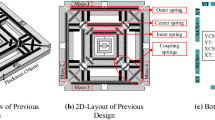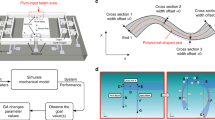Abstract
In this paper, we apply the topology optimization method to the design of MEMS gyroscopes, with the aim of supporting traditional trial and error design procedures. Using deterministic, gradient-based mathematical programming, the approach is here applied to the design of 2D in-plane single mass MEMS gyroscopes. We first focus on a benchmark academic case, for which we present and compare three different formulations of the optimization problem, considering typical industrial requirements. These include the maximization of the response of the sensor’s structure to the external angular rate, target resonant frequencies and minimum or constrained material usage. Also, a minimum length scale is imposed to the geometric features in order to ensure manufacturability, and an explicit penalization of grey elements is proposed to improve convergence to black and white layouts. Once the suitability of the method has been assessed, the formulation associated with the lowest computational cost, i.e. the one considering static estimations of the resonant frequencies, is applied to the design of a real-world MEMS gyroscope, targeting different resonant frequencies.




















Similar content being viewed by others
References
Aage N, Andreassen E, Lazarov BS, Sigmund O (2017) Giga-voxel computational morphogenesis for structural design. Nature 550(7674):84–86
Acar C, Shkel A (2001) A design approach for robustness improvement of rate gyroscopes. In: MSM, International Conference on Modeling and Simulation of Microsystems, vol 4, pp 80–83
Acar C, Shkel AM (2005) Structurally decoupled micromachined gyroscopes with post-release capacitance enhancement. J Micromech Microeng 15(5):1092–1101
Acar C, Shkel A (2009) MEMS vibratory gyroscopes. MEMS reference shelf. Springer, Boston
Bendsoe MP, Sigmund O (2004) Topology optimization, vol 95. Springer, Berlin
Bendsøe MP, Sigmund O (1999) Material interpolation schemes in topology optimization. Arch Appl Mech (Ingenieur Archiv) 69(9-10):635–654
Benkhelifa E, Farnsworth M, Tiwari A, Bandi G, Zhu M (2010a) Design and optimisation of microelectromechanical systems: a review of the state-of-the-art. Int J Des Eng 3(1):41
Benkhelifa E, Farnsworth M, Tiwari A, Zhu M (2010b) Evolutionary algorithms for planar MEMS design optimisation: a comparative study 284:199–210
Bernstein J, Cho S, King A, Kourepenis A, Maciel P, Weinberg M (1993) A micromachined comb-drive tuning fork rate gyroscope. [1993] Proceedings IEEE Micro Electro Mechanical Systems, pp 143–148
Bourdin B (2001) Filters in topology optimization. Int J Numer Methods Eng 50(9):2143–2158
Bruggi M, Zega V, Corigliano A (2016) Optimization of auxetic structures for MEMS applications. 2016 17th International Conference on Thermal, Mechanical and Multi-Physics Simulation and Experiments in Microelectronics and Microsystems, EuroSimE 2016, pp 1–5
Bruns TE, Tortorelli DA (2001) Topology optimization of non-linear elastic structures and compliant mechanisms. Comput Methods Appl Mech Eng 190(26-27):3443–3459
Chen F, Chang H, Yuan W, Wilcock R, Kraft M (2012) Parameter optimization for a high-order band-pass continuous-time sigma-delta modulator MEMS gyroscope using a genetic algorithm approach. J Micromech Microeng 22(10):105006
Clausen A, Andreassen E (2017) On filter boundary conditions in topology optimization. Struct Multidiscip Optim 56(5):1147–1155
Cook RD (1995) Finite element modeling for stress analysis
Di̇aaz AR, Kikuchi N (1992) Solutions to shape and topology eigenvalue optimization problems using a homogenization method. Int. J. Numer. Methods Eng. 35(7):1487–1502
Farnsworth M, Tiwari A, Zhu M (2017) Multi-level and multi-objective design optimisation of a MEMS bandpass filter. Appl Soft Comput J 52:642–656
Guest JK, Prėvost JH, Belytschko T (2004) Achieving minimum length scale in topology optimization using nodal design variables and projection functions. Int J Numer Methods Eng 61(2):238–254
Haronian D (1995) Maximizing microelectromechanical sensor and actuator sensitivity by optimizing geometry
Jog C (2002) Topology design of structures subjected to periodic loading. J Sound Vib 253(3):687–709
Kempe V (2011) Inertial MEMS. Cambridge University Press, Cambridge
Krog L, Tucker A, Kemp M, Boyd R (2004) Topology optimisation of aircraft wing box ribs. In: 10th AIAA/ISSMO Multidisciplinary Analysis and Optimization Conference. . American Institute of Aeronautics and Astronautics, Reston
Kulygin A, Kirsch C, Schwarz P, Schmid U, Seidel H (2012) Decoupled surface micromachined gyroscope with single-point suspension. J Microelectromech Syst 21(1):206–216
Ma Z-D, Cheng H-C, Kikuchi N (1994) Structural design for obtaining desired eigenfrequencies by using the topology and shape optimization method. Comput Syst Eng 5(1):77–89
Ma Z-D, Kikuchi N, Cheng H-C (1995) Topological design for vibrating structures. Comput Methods Appl Mech Eng 121(1-4):259–280
Olhoff N (1989) Multicriterion structural optimization via bound formulation and mathematical programming. Struct Optim 1(1): 11–17
Pedersen N (2000) Maximization of eigenvalues using topology optimization. Struct Multidiscip Optim 20 (1):2–11
Philippine MA, Sigmund O, Rebeiz GM, Kenny TW (2013) Topology optimization of stressed capacitive RF MEMS switches. J Microelectromech Syst 22(1):206–215
Poulsen TA (2003) A new scheme for imposing a minimum length scale in topology optimization. Int J Numer Methods Eng 57(6):741–760
Sahin K, Sahin E, Alper SE, Akin T (2009) A wide-bandwidth and high-sensitivity robust microgyroscope. J Micromech Microeng 19(7)
Sardan O, Petersen DH, Mølhave K, Sigmund O, Bøggild P (2008) Topology optimized electrothermal polysilicon microgrippers. Microelectron Eng 85(5-6):1096–1099
Seyranian AP, Lund E, Olhoff N (1994) Multiple eigenvalues in structural optimization problems. Struct Optim 8(4):207–227
Sigmund O (2001) Design of multiphysics actuators using topology optimization –part I: one-material structures. Comput Methods Appl Mech Eng 190(49-50):6605–6627
Solouk MR, Shojaeefard MH, Dahmardeh M (2019) Parametric topology optimization of a MEMS gyroscope for automotive applications. Mech Syst Signal Process 128:389–404
Stolpe M, Svanberg K (2001) An alternative interpolation scheme for minimum compliance topology optimization. Struct Multidiscip Optim 22(2):116–124
Sung WK, Dalal M, Ayazi F (2011) A mode-matched 0.9 MHZ single proof-mass dual-axis gyroscope. 2011 16th International Solid-State Sensors, Actuators and Microsystems Conference, TRANSDUCERS’11, pp 2821–2824
Svanberg K (1987) The method of moving asymptotes - a new method for structural optimization
Svanberg K (2002) Methods based on conservative convex separable. Society 12(2):555–573
Tcherniak D (2002) Topology optimization of resonating structures using SIMP method. Int J Numer Methods Eng 54(11):1605–1622
Tenek LH, Hagiwara I (1993) Static and vibrational shape and topology optimization using homogenization and mathematical programming. Comput Methods Appl Mech Eng 109(1-2):143–154
Trusov AA, Schofield AR, Shkel AM (2011) Micromachined rate gyroscope architecture with ultra-high quality factor and improved mode ordering. Sens Actuat A: Phys 165(1):26–34
Vigna B (2011) Tri-axial MEMS gyroscopes and six degree-of-freedom motion sensors. Technical Digest - International Electron Devices Meeting, IEDM, pp 662–664
Wang F, Lazarov BS, Sigmund O (2011) On projection methods, convergence and robust formulations in topology optimization. Struct Multidiscip Optim 43(6):767–784
Xia D, Kong L, Gao H (2015) Design and analysis of a novel fully decoupled tri-axis linear vibratory gyroscope with matched modes. Sens (Switzerland) 15(7):16929–16955
Zaman M, Sharma A, Ayazi F (2006) High performance matched-mode tuning fork gyroscope. In: 19th IEEE International Conference on Micro Electro Mechanical Systems, number January. IEEE, pp 66–69
Xia D, Yu C, Kong L (2014) The development of micromachined gyroscope structure and circuitry technology. Sens (Switzerland) 14(1):1394–1473
Zhou M, Lazarov BS, Wang F, Sigmund O (2015) Minimum length scale in topology optimization by geometric constraints. Comput Methods Appl Mech Eng 293:266–282
Acknowledgements
Daniele Giannini and Francesco Braghin would like to thank the AMG R&D team of STMicroelectronics, who provided the industrial insight and expertise that greatly assisted the research. Niels Aage acknowledges the support of the Villum Foundation as part of the InnoTop VILLUM Investigator project.
Funding
This study was funded by STMicroelectronics (grant code 081/16CR) and Villum Foundation (InnoTop VILLUM Investigator project).
Author information
Authors and Affiliations
Corresponding author
Ethics declarations
Conflict of interest
Francesco Braghin and Daniele Giannini received research grants from the commercial company STMicroelectronics, active in the MEMS field.
Additional information
Responsible Editor: Emilio Carlos Nelli Silva
Publisher’s note
Springer Nature remains neutral with regard to jurisdictional claims in published maps and institutional affiliations.
Replication of results
The manuscript provides all the information needed by readers to replicate the presented results. The authors have stored all data related to the presented examples and ensured that all relevant parameters are stated clearly throughout the manuscript. Furthermore, the code can be made available upon request to the corresponding author.
Appendices
Appendix: 1: Adjoint sensitivity analysis of the sense response
In order to compute the sensitivities of the sense response ψ1 (12) with respect to the projected field, we first consider the corresponding harmonic response problem:
and rewrite it introducing the dynamic stiffness matrix S as well as expliciting the dependencies on the projected field and on the sense resonant frequency:
Considering that:
Equation (33) can be split into its real and imaginary parts as:
Referring to Eq. 12, the sense response ψ1 can be expressed as a function of the projected field and of the real and imaginary parts of the harmonic displacements vector:
As usual for adjoint sensitivity analysis, we add to this function extra (vanishing) terms that are related to the harmonic response to the sense eigenvalue problem and to the normalization of the sense modal shape:
We now compute the sensitivities of the above function with respect to the projected field that after rearranging the terms become:
In order to eliminate the expressions involving \(\frac {\partial \boldsymbol {u_{h,r}}}{\partial \overline {\tilde {\gamma }}_{e}}\) and \(\frac {\partial \boldsymbol {u_{h,i}}}{\partial \overline {\tilde {\gamma }}_{e}}\), we require the first two parentheses to vanish:
Multiplying the second equation in Eq. 39 by i and adding it to the first one yields:
that after introducing λ∗ = λ1 + iλ2 and S = Sr + iSi, and after transposing, gives (21) that allows to compute the adjoints λ1 and λ2.
In order to compute the adjoints λ3 and λ4, we instead eliminate the expressions involving \(\frac {\partial \omega _{s}}{\partial \overline {\tilde {\gamma }}_{e}}\) and \(\frac {\partial \boldsymbol {{\Phi }_{s}}}{\partial \overline {\tilde {\gamma }}_{e}}\), i.e. we require the last two parentheses in Eq. 38 to vanish. After transposing, this yields (23) that allows to compute λ3 and λ4.
The final expression of the sensitivities of ψ1 (20) can be obtained from Eq. 38 by removing the four eliminated terms.
Appendix 2: Adjoint sensitivity analysis of the statically estimated modal stiffness and mass
The sensitivities of the statically estimated resonant frequencies (27) are obtained from the sensitivities of the statically estimated modal stiffness and mass (28).
In order to compute the sensitivities of the statically estimated modal stiffness \(\tilde {k}_{m,i}\) with respect to the projected field, we first consider the correspondent static load case and partition it into the sets of free and constrained degrees of freedom (pedices f and c respectively):
Following the partition, the expression for \(\tilde {k}_{m,i}\) becomes:
We then add to \(\tilde {k}_{m,i}\) two vanishing terms related to the two sets of equations in Eq. 41:
The sensitivities of the above function with respect to the projected field, after rearranging the terms, become:
Requiring the terms that multiply \(\frac {\partial \boldsymbol {\tilde {\Phi }_{i,f}}}{\partial \overline {\tilde {\gamma }}_{e}}\) and \(\frac {\partial \boldsymbol {f_{i,c}}}{\partial \overline {\tilde {\gamma }}_{e}}\) to vanish, we get:
Being the right-hand side null because of Eq. 41, we conclude that ν1 = 0 and ν2 = 0 that substituted in Eq. 44 gives the sensitivities of the statically estimated modal stiffness in Eq. 28.
The sensitivities of the statically estimated modal mass can be obtained by first expressing \(\tilde {m}_{m,i}\) following the partition in Eq. 41 and then adding the vanishing terms related to the static load case as in Eq. 43. Thus:
We now repeat the same procedure as before: we compute the sensitivities of Eq. 46 and we require the terms that multiply \(\frac {\partial \boldsymbol {\tilde {\Phi }_{i,f}}}{\partial \overline {\tilde {\gamma }}_{e}}\) and \(\frac {\partial \boldsymbol {f_{i,c}}}{\partial \overline {\tilde {\gamma }}_{e}}\) to vanish. We therefore obtain (29) that allows to compute the adjoint vector \(\boldsymbol {\mu }=[\boldsymbol {\mu _{1}}^{T}, \boldsymbol {\mu _{2}}^{T}]^{T}\), and we get also the final expression of the sensitivities of the statically estimated modal mass (28) by removing the eliminated terms.
Rights and permissions
About this article
Cite this article
Giannini, D., Braghin, F. & Aage, N. Topology optimization of 2D in-plane single mass MEMS gyroscopes. Struct Multidisc Optim 62, 2069–2089 (2020). https://doi.org/10.1007/s00158-020-02595-3
Received:
Revised:
Accepted:
Published:
Issue Date:
DOI: https://doi.org/10.1007/s00158-020-02595-3




